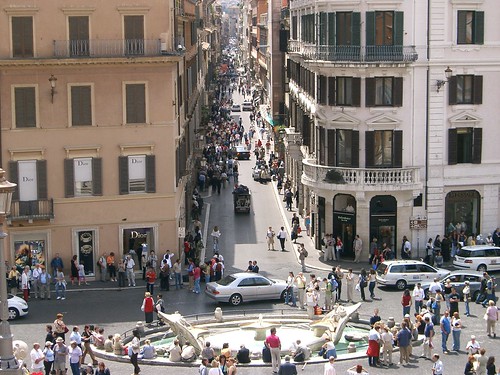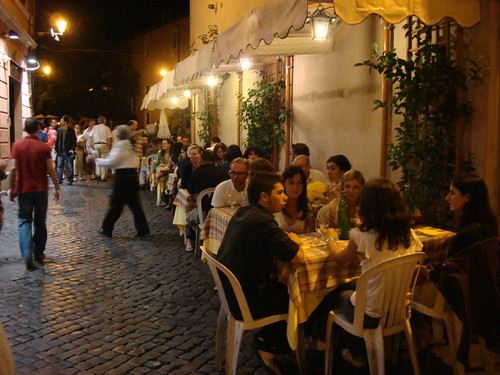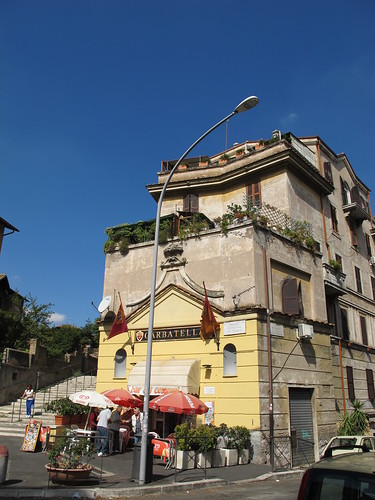The move of the charm of Garbatella Trastevere, a walk down other streets in the Italian capital, near the historic center. Is one of those sunsets that one wishes that never ends. In the Piazza di Santa Maria in Trastevere, Rome, the spring sun warms the souls of many who, following almost a tradition, sit on the steps of the fountain enjoying a cool beer or ice cream.

Photography by edwin.11
Around, the pedestrian streets are full of people in the souvenir shops and wait to be seen. It is the heart of Trastevere, which has become a required course in Rome, an attraction that adds to the long list of «captive» that goes from the Colosseum and Roman Forum, Vatican to Fontana di Trevi, Spagna piazzas of Navona and Campo dei Fiori.
Is that beyond these attractions unavoidable, the capital of Italy deserves to be known from certain neighborhoods, in their early and then made popular fashion as Trastevere itself, but also Testaccio and San Lorenzo Garbatella. Populated with bars and restaurants, these areas adjacent to the historic center became centers of the night and the Roman scene, with the bonus track of them can still see pensioners playing cards or chatting old bars street with tourists who discover the charm of a «Rome neighborhood and street markets. Is that going through the neighborhood one can understand, or at least imagine what the city was about 40 or 50 years.

Photography by scalleja
These four districts have very ancient origins, as were most regions of imperial Rome, which were initially four but that the Emperor Augustus, before zero, increased to 14. From the Gianicolo hill you can get a good view of Rome, just below, a view of Trastevere, which was the rioni XIII and also one of the most populous of ancient Rome, where communities living abroad, especially Syrians and Jews, working in the nearby port Emporium. He was also one of the first to become a bustling downtown, and since the end of World War II. Not lacking, even those who risk it at this point and went out of fashion, but the facts say otherwise: its streets are full of people (Italians and tourists) that circulate in bars, trattorias and restaurants, some almost legendary, as the original local La Parolaccia, number 3 of Vicolo del Cinque.
So many people adds life and color to a neighborhood that was able to maintain much of the atmosphere of early twentieth century, and even parts sampietrini retains the old, typical floor tile formed by black porphyritic (sampietrino) created during the reign of Pope Sixtus V.
Trastevere invited to travel quiet, step by step, through its narrow streets, especially from the Piazza di Santa Maria in Trastevere and III century basilica. Nearby, in the old Bar San Calisto, people and characters from different generations come together to chat, play chess or share sgroppino cocktail typical household. The district exhibits works by artists like Pietro Cavallini, Raphael and Bernini, the latter, author of the beautiful circular temple of San Pietro in Montorio, where it is said, was martyred St. Peter. You can also view the collections of paintings in the Palazzo Corsini, the Porta San Pancrazio Porta and Settimiana (both in the Aurelian Walls).
Testaccio – The neighborhood of «Rome»
Testaccio, formerly a popular area with two beds, a market and taverns which were supplied from the slaughterhouse in the area, in recent decades was recycled itself. The name comes from Mount Testaccio. The neighborhood used to be the gateway for goods of Imperial Rome, and boats, many loaded with olive oil from Andalusia (now Cordova), Tripolitania (Libya) or Gaul, the river discharged. The empty ballot boxes were broken and its fragments formed this mountain, 40 meters.
Perhaps best of places like Testaccio is that they have known much recycled without changing its appearance. So today the neighborhood, night life, keep those communities neighboring buildings, gatehouse and courtyard, her half unpainted walls, wires across the streets without shame, the clothes drying in the light of all and the Pizza al taglio to enjoy and follow.

Photography by scalleja
The old slaughterhouse and refrigerated (Mattatoio) is a footprint as became social and cultural center, near Macro Works (Museum of Contemporary Art, Rome), in an old brewery. And in Piazza Testaccio is organized as a popular market before, with handwritten signs and offers of food, clothing, and utensils.
Next to the Porta San Paolo, in the Protestant Cemetery or Poets, rest, among others, the remains of Antonio Gramsci and the English poet John Keats. But besides these poetic air, Testaccio is also «the suburb of Rome, the heart of many computer Romans.
Garbatella – Garden City
In Garbatella there are few tourists, but is certainly the most colorful and unique neighborhood of Rome, with a good selection of restaurants nearby Roman cuisine. But what makes it unique is its architecture named «Barocchetto» (for his inspiration in the Baroque), which is even under consideration for many students. Some describe it by saying that «it is a place that belonged to nobody, and now belongs to everyone», but also may jeopardize that probably is destined to become a major cultural districts of Rome.

Photography by ho visto nina volare
Its nightlife is not as strong as in Trastevere and San Lorenzo, but the presence of the Third University streamlines the night with bars and pubs between the Via Ostiense, the Gazometro and the new Palladium Theater again today. Nearby, across the Ostiense, is the Basilica of Saint Paul Outside the Walls, one of the five churches of Rome’s oldest and largest after San Pedro, with a monumental central nave clad in marble. Copyright offshore of the Holy See, and houses the tomb of the apostle Paul.
The University District:
The San Lorenzo district, near the Termini station takes its name from the nearby Basilica of San Lorenzo outside the Walls. The presence of the University «La Sapienza», with nearly 150,000 students is the largest in Europe, brings a youth that keeps the nightlife in restaurants, pizzerias, pubs and clubs. Old working class neighborhood, San Lorenzo is now the «university district» of Rome, bohemian, walls painted with political and leftist party headquarters.
By day it’s a neighborhood to relax among restaurants offering home gnoccis, pizzerias, casual clothing shops second hand Japanese cosmetic or Bach flowers. There are multipurpose centers as Drome, where you can see theater, surfing the Internet or try vegetarian food. Or sites like Formula One, which has over 20 years serving pizza with homemade mozzarella or baccalà (cod), fried typical Roman dish.
Porta Portese – More than four thousand stalls
Among the popular market of Rome (which are many) the most famous is the Porta Portese, which operates very early Sunday near the Ponte Sublicio in the neighborhood of Trastevere. Its origins date back to World War II, when it was the black market in the city. Today, mainly in the Milky Portuense but also surrounding streets, nearly four thousand stalls offer literally all, of the most useful at best useless, at which magma, running time and patience to stir, you can find products While decent prices. The stands are beginning to settle from the morning, and as early as seven o’clock discs are packed with antique furniture, clothes from 1 euro, hats, football shirts, tools, antique radios, food, bicycles, souvenirs of the Soviet Union , books. It should go early, because even before the 11 crowd begins to hinder the walk. After noon the posts begin to be dismantled, and everything is settled at a discount. Well worth a visit.

Photography by climens
Volpetti – Taste of Roman roads
A Rome must know it by foot, and in that walk, we must take advantage to enjoy the cuisine, which is very rich. And it is almost obligatory to eat on the street, for example, a pizza al taglio, which are very good, or made up for good, rice and meat croquettes stuffed with mozzarella. Roman cuisine is as simple as tasty, and the Romans are traditionalists in the flavors: the Roman fettuccine, spaghetis, pizza, bologna, beef stew, salsa Matriciana, but romanized native of Abruzzo. The Roman Porchetta is also very common, found everywhere, but probably the most famous dish is that of the artichokes, in various forms and preparations, but always delicious. Along the Trastevere, the ghetto or Jewish quarter has a very interesting kitchen, half Roman and half Jewish. And now, as summer begins, we must enjoy the tradition of grattachecca, a rind of ice several flavors sold in plastic cups, sometimes with fresh fruit. In summer it is a traditional delicacy in the street and is available in many newsagents, especially near the Tiber.

Photography by rioncm
Discover the neighborhoods of Rome!
Leave a Reply
You must be logged in to post a comment.
Recent Comments